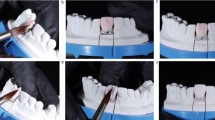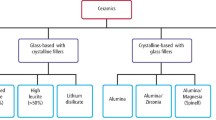Abstract
Lithium disilicate has become very popular and is very commonly used, especially for highly aesthetic cases. It has also proven to be a very durable material and can be used in a variety of clinical situations. It is important as a clinician, technician or ceramist to be able to confidently use this material by appreciating the detail in its construction. The microstructure has a significant impact on the optical and physical properties of this material. Hence, before the prescription of this type of restoration, it is imperative to be knowledgeable in this aspect. This article explores lithium disilicate as a dental ceramic material in detail.
Key points
-
Explains how the microstructure of lithium disilicate has an impact on its physical properties.
-
Identifies what considerations need to be made in the preparation design when lithium disilicate is the material of choice.
-
Explains the appropriate cementation technique for lithium disilicate ceramics.
This is a preview of subscription content, access via your institution
Access options
Subscribe to this journal
Receive 24 print issues and online access
$259.00 per year
only $10.79 per issue
Buy this article
- Purchase on Springer Link
- Instant access to full article PDF
Prices may be subject to local taxes which are calculated during checkout

Similar content being viewed by others
References
Willard A, Gabriel Chu T M. The science and application of IPS e.Max dental ceramic. Kaohsiung J Med Sci 2018; 34: 238-242.
Stappert C F, Att W, Gerds T, Strub J R. Fracture resistance of different partial-coverage ceramic molar restorations: An in vitro investigation. J Am Dent Assoc 2006; 137: 514-522.
Zarone F, Ferrari M, Mangano F G, Leone R, Sorrentino R. "Digitally Oriented Materials": Focus on Lithium Disilicate Ceramics. Int J Dent 2016; DOI: 10.1155/2016/9840594.
Kern M, Sasse M, Wolfart S. Ten-year outcome of three-unit fixed dental prostheses made from monolithic lithium disilicate ceramic. J Am Dent Assoc 2012; 143: 234-240.
Gehrt M, Wolfart S, Rafai N, Reich S, Edelhoff D. Clinical results of lithium-disilicate crowns after up to 9 years of service. Clin Oral Investig 2013; 17: 275-284.
Fabbri G, Zarone F, Dellificorelli G et al. Clinical evaluation of 860 anterior and posterior lithium disilicate restorations: retrospective study with a mean follow-up of 3 years and a maximum observational period of 6 years. Int J Periodontics Restorative Dent 2014; 34: 165-177.
Sailer I, Makarov N A, Thoma D S, Zwahlen M, Pjetursson B E. All-ceramic or metal-ceramic tooth-supported fixed dental prostheses (FDPs)? A systematic review of the survival and complication rates. Part I: Single crowns (SCs). Dent Mater 2015; 31: 603-623.
Lien W, Roberts H W, Platt J A, Vandewalle K S, Hill T J, Chu T M. Microstructural evolution and physical behaviour of a lithium disilicate glass-ceramic. Dent Mater 2015; 31: 928-940.
Denry I, Holloway J A. Ceramics for Dental Applications: A Review. Materials (Basel) 2010; 3: 351-368.
Saint-Jean S J. Dental Glasses and Glass-ceramics. In Shen J Z, Kosmac T (eds) Advanced Ceramics for Dentistry. pp 416. Oxford: Butterworth-Heinemann, 2013.
Hallmann L, Ulmer P, Kern M. Effect of microstructure on the mechanical properties of lithium disilicate glass-ceramics. J Mech Behav Biomed Mater 2018; 82: 355-370.
Culp L, McLaren E A. Lithium disilicate: the restorative material of multiple options. Compend Contin Educ Dent 2010; 31: 716-720.
Alkadi L, Ruse N D. Fracture toughness of two lithium disilicate dental glass ceramics. J Prosthet Dent 2016; 116: 591-596.
Vivadent I. IPS e.max CAD Scientific Documentation. Liechtenstein, 2005.
Azar B, Eckert S, Kunkela J, Ingr T, Mounajjed R. The marginal fit of lithium disilicate crowns: Press vs. CAD/CAM. Braz Oral Res 2018; DOI: 10.1590/1807-3107/2018.vol32.0001.
Alayad A S, Alqhatani A, Alkatheeri M S et al. Effects of CAD/-AM ceramics and thicknesses on translucency and colour masking of substrates. Saudi Dent J 2021; 33: 761-768.
Bacchi A, Boccardi S, Alessandretti R, Pereira G K R. Substrate masking ability of bilayer and monolithic ceramics used for complete crowns and the effect of association with an opaque resin-based luting agent. J Prosthodont Res 2019; 63: 321-326.
Tabatabaei M H, Matinfard F, Ahmadi E, Ranjbar Omrani L, Sadeghi Mahounak F. Colour Stability of Ceramic Veneers Cemented with Self-Adhesive Cements after Accelerated Aging. Front Dent 2019; 16: 393-401.
Seyidaliyeva A, Rues S, Evagorou Z, Hassel A J, Rammelsberg P, Zenthofer A. Colour stability of polymerinfiltratedceramics compared with lithium disilicate ceramics and composite. J Esthet Restor Dent 2020; 32: 43-50.
Vivadent I. IPS e.max Press - Lab to Dentist. Liechtenstein, 2020.
Vivadent I. IPS e.max Press Scientific Documentation. Liechtenstein, 2011.
Vivadent I. IPS e.max CAD Instructions for use. Liechtenstein, 2019.
Aboushelib M N, Sleem D. Microtensile bond strength of lithium disilicate ceramics to resin adhesives. J Adhes Dent 2014; 16: 547-552.
Fasbinder D J, Dennison J B, Heys D, Neiva G. A clinical evaluation of chairside lithium disilicate CAD/CAM crowns: a two-year report. J Am Dent Assoc 2010; DOI: 10.14219/jada.archive.2010.0355.
Guimaraes H A B, Cardoso P C, Decurcio R A et al. Simplified Surface Treatments for Ceramic Cementation: Use of Universal Adhesive and Self-Etching Ceramic Primer. Int J Biomater 2018; DOI: 10.1155/2018/2598073.
Tian T, Tsoi J K-H, Matinlinna J P, Burrow M F. Aspects of bonding between resin luting cements and glass ceramic materials. Dent Mater 2014;DOI: 10.1016/j.dental.2014.01.017.
Ozcan M, Allahbeickaraghi A, Dundar M. Possible hazardous effects of hydrofluoric acid and recommendations for treatment approach: a review. Clin Oral Investig 2012; 16: 15-23.
Pieger S, Salman A, Bidra A S. Clinical outcomes of lithium disilicate single crowns and partial fixed dental prostheses: a systematic review. J Prosthet Dent 2014; 112: 22-30.
Acknowledgements
Fine Art Studio Dental Lab, Birmingham, produced the ceramic work in Figure 1 and we thank them for all of their support.
Author information
Authors and Affiliations
Contributions
Kiran Kaur: lead author; conceptualisation; drafting the manuscript; reviewing and editing of the manuscript to create the final version; and referencing. Mojgan Talibi: second author; conceptualisation; reviewing and editing of the manuscript to create final manuscript; and photographing images and producing them into figures. Hiten Parmar: supervisor and reviewing the manuscript.
Corresponding author
Ethics declarations
The authors declare no conflicts of interest.
Rights and permissions
About this article
Cite this article
Kaur, K., Talibi, M. & Parmar, H. Do you know your ceramics? Part 3: lithium disilicate. Br Dent J 232, 147–150 (2022). https://doi.org/10.1038/s41415-022-3882-x
Received:
Accepted:
Published:
Issue Date:
DOI: https://doi.org/10.1038/s41415-022-3882-x
This article is cited by
-
Influence of thickness and surface conditioning on fracture resistance of occlusal veneer
BMC Oral Health (2023)



